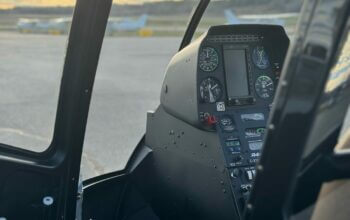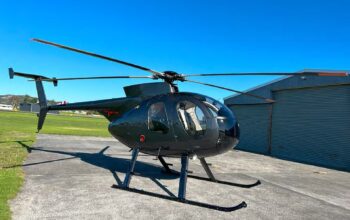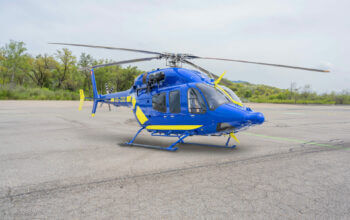Three months ago, U.K.-based Hill Helicopters emerged from stealth, promising to revolutionize the light helicopter industry with its concept for a sleek, five-seat turbine helicopter model called the HX50. Now, the company has revealed how it plans to bring the HX50 to market as early as 2023 at a price point of just £495,000 (US$665,000) — wildly ambitious targets for any certified helicopter program, as Hill Helicopters founder Jason Hill is quick to acknowledge.

“For a new, innovative product to inject the kind of step change in technology that the [helicopter] industry needs, if you were to try and do it the certified route, you’d need huge amounts of money; you’d need to be pre-production for a decade. And it’s just not a viable business model,” Hill told Vertical in an exclusive interview.
So instead of launching the HX50 as a certified aircraft, Hill Helicopters plans to debut it as an experimental category, amateur-built model, eliminating many of the regulatory layers associated with certification. HX50 sales and experience will then be used to support a full certification process, resulting in an otherwise identical (but predictably more expensive) commercial model, the HC50.
According to Hill, pursuing the more streamlined amateur-built framework for initial type approval “allows us to take more of the responsibility ourselves, meet all the same regulations, but get the product to market much, much faster than would have been possible with a traditional certification route. And then once the product is in the market, it becomes very difficult for a certification body to argue that ‘Oh, it’s a terrible idea, it’s very dangerous, it’s too risky,’ if we’ve got 1,000 or 2,000 of them out there already with an exemplary safety record.”

That might sound wildly ambitious as well, given that amateur-built helicopters — which require the owner/operator to build at least 51 percent of the aircraft — have always represented a small and accident-prone niche of the larger market. But Hill, an aeronautics PhD and pilot who previously worked on helicopter programs at GKN Westland (now Leonardo), is aiming at nothing less than “fixing the ills of a broken industry.”
“The products we’re flying around today were out of date in the 1980s; they’re decades out of date,” he said. “We need a very large injection of innovation to bring general aviation back to life. We need modern technology, we need more connected aircraft, we need higher performance aircraft, we need better crashworthiness, we need to improve the desirability.”
That’s what Hill believes he can offer with the HX50, which his company is designing from the wheels up, including its avionics suite and GT50 turbine engine. Hill is betting that the desirability of the model will attract a substantial new customer base of private owners, whose participation in the build process will make them more knowledgeable and conscientious pilots.

Unlike most experimental aircraft, the HX50 won’t be available as a kit for homebuilding. Instead, customers will be required to assemble their aircraft in a “carefully choreographed” two-week factory course alongside licensed engineers. Then, rather than sending them off to operate in isolation, the company plans to stay connected with the owner community through a cloud-based operating platform that will include flight data monitoring services, “so we’ll be able to provide a degree of support and oversight and monitoring of each of the aircraft we sell,” Hill said.
Amateur-built aircraft cannot be used for commercial operations, but because the HX50 is targeted squarely at private owners, Hill doesn’t expect that to be a deal-breaker for most of them. Indeed, he suggested that the owner build requirement will even be a selling point for affluent consumers who are seeking one-of-a-kind experiences, not just luxury goods. “The experience of being involved in manufacturing the helicopter that they then went on to fly around the world is an incredibly attractive proposition to a lot of these people — far, far more so than people would necessarily realize,” he said.
Because the HX50 is being designed to meet the latest Federal Aviation Administration and European Union Aviation Safety Agency (EASA) certification standards for part 27 normal category rotorcraft, Hill doesn’t anticipate any of the weight or occupancy limitations that have been placed on some experimental aircraft models. “Type approval for HX50 will require us to do as much or more testing, and to the same standards, as would [be] required for a full certification process,” he emphasized, noting that the company is already well on its way to having a flying prototype: “People are judging the timescale based on assuming we’re starting from scratch now, [but] this project’s been going on for a long time.”

Hill said the U.K.’s Civil Aviation Authority (CAA) has been “incredibly supportive” of the concept to date. And while Brexit has caused angst in some corners of the aerospace industry, Hill is optimistic that it will prove to be an advantage in bringing the HX50 to market.
“Brexit has been a real enabler because we’ve now got new powers coming home, so the U.K. will be able to certify its own aircraft again,” rather than relying on EASA, he explained. “The U.K. CAA is a much smaller, more agile, more responsive and much, much, much, much cheaper organization to work with.”
Hill stressed that his goal in pursuing initial type approval of the HX50 as an amateur-built aircraft is not to shortcut safety measures, but instead to speed the introduction of modern, safety-enhancing technologies that have been disincentivized by the existing part 27 certification process.

“The general certification process is fabulous if you happen to be a commercial aircraft manufacturer,” he explained. “But the fixed costs associated with certification don’t scale down well to GA [general aviation], and all they’ve ended up doing is locking in these old technologies and these old proven things where you’ve got manufacturers scrambling to avoid introducing perceived technical risk into their products.”
By sticking with old technology, Hill said, rotorcraft manufacturers have consistently failed to win over the large potential customer base of people who could afford helicopters, but who see today’s light helicopters as too difficult to fly, too risky, or simply too ugly to be desirable. He believes that if more of these people are brought into the market, manufacturing volumes will increase to the point that certifying modern technology will become viable.
“The whole industry is broken. We’ve obviously taken quite an assertive and disruptive strategy with the way we’re bringing this to market, but the industry needs that,” Hill told Vertical.
Of course, certification is only one of the things that drags out the timeline for bringing new aircraft to market. Flight test campaigns routinely uncover design flaws that take time and money to fix, and it will be remarkable indeed if both the HX50 and GT50 engine development programs proceed without hiccups. But Hill claims to have already received a “surprising” number of orders from buyers around the world who believe not just in his aircraft, but in his mission to revitalize private helicopter ownership.
“What we’re offering to these people isn’t just a revolutionary helicopter — it’s an ability to be part of the movement to relaunch GA,” he said. “These people are all very, very passionate about aviation. They love helicopters, they love the helicopter lifestyle, they just know it can be more.”








